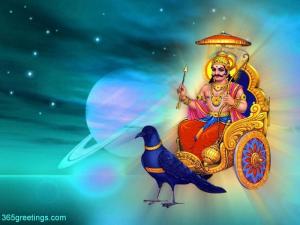From my earlier posts we are already familiar with the universal prohibitions arising from the nature of the Tithi ( Hindu Lunar day), the daily Chaughadias ( hourly change in auspicious and inauspicious phases of the day) eclipses etc. The longer term prohibitions become more significant as they affect Hindu social life and commercial activity over extended periods as contrasted with the shorter term prohibitions which pass quickly from hour to hour or Lunar day to Lunar day. These prohibitions relate to ‘universal effects’ as contrasted with ‘individual effects’ which are the concern of the horoscope of an individual or sometimes of a national unit.These universal prohibitions, applicable to all are governed by the following astrological or astronomical events:
DAKSHINAYAN
The fundamental precept of long-term prohibitions arise from the belief that when the Sun is in Uttarayan (Norther swing) moving from the tropic of Capricorn to the tropic of Cancer, it is an auspicious time as the Sun becomes stronger and empowered with every passing day. The commencement of this process is marked by the great festival of Makar Sakranti ( entry of the Sun into Capricorn) mid January, with great rejoicing, kite flying and feeding cattle around town. When the Sun is in Dakshinayan ( southern swing) moving from Cancer to Capricorn, its rays grow weaker, losing power and the time is less auspicious. This is marked by Kark Sakranti ( entry into Cancer), mid July. If this were strictly observed or enforced, no auspicious activity like marriage, inauguration of temples , entry into a new home, ceremonial tonsure of a child’s hair, coronation or assumption of important office etc etc would be astrologically recommended during a six month period during each year. Fortunately, relief has been provided in the month of Margsheesh ( November-December) but only till the Sun enters Sagittarius ( Dhanu Sakranti) in mid-December when the prohibition becomes total as in this month the Sun is at its weakest in the year. This period is called the Malmas, the dark month.The prohibition ends with Makar Sakranti and suddenly there are marriages everywhere once again. Even a former Governor of Rajasthan state waited till Makar Sakranti before assuming office.
SHRAAD
Soon after the Dakshinayan phase commences, come the further prohibitions on account of Shraad. These are observances which are not festive but equally essential. We are said to be born with two types of obligations: debts to the gods ( Dev Rinn) and those to the ancestors ( Pitri Rinn). Dev Rinns are discharged through prayer and ritual and the first half of every day is for that. Pitri Rinn is discharged through ritual observances for ancestors and the latter half of the day is appropriate for that. Both are to be undertaken with the Sun as witness, therefore preferably between sunrise and sunset.
The Shraads commence with the full-moon of the month of Bhadrapad and end with the no-moon of the month of Ashwin, generally falling in the month of September each year, prior to the Sharad ( Winter) Navratra ( discussed in the post on fasts). This is a fortnight during the year which is reserved for deceased ancestors. Ancestors include three generations of parents, grandparents and great grand parents and uncles, aunts and siblings who have no progeny other than yourself to honour them. That which is done with Shraddha, faith, is Shraad. During the Shraads all other auspicious and festive events are prohibited. Each of the fifteen Shraad days is dedicated to the ancestor who died on that Tithi. Prayers and offerings to ancestors consist of preparations of rice, lentil and milk and the favourite food of that ancestor if known and then distributed to five beings – a cow, a crow, a dog, ants and a beggar – called the Panch Gras. Thereafter Brahmins are fed. This upholds an ancient tradition of feeding all manner of beings before consuming ones righteous repast. Through the mouths of these beings the ancestors are satisfied and honoured.  It is believed that the ancestors are permitted to visit the mortal world from their realms as spirits during this period to observe whether they are still loved and remembered. Most people observe these rituals meticulously as it is believed that one will be blessed with progeny and they will be assured long life and a successful career only if the ancestors thus honoured bless the family. The principle is that you are only entitled to future generations if you care to remember and honour your past generations – sounds quite logical.
It is believed that the ancestors are permitted to visit the mortal world from their realms as spirits during this period to observe whether they are still loved and remembered. Most people observe these rituals meticulously as it is believed that one will be blessed with progeny and they will be assured long life and a successful career only if the ancestors thus honoured bless the family. The principle is that you are only entitled to future generations if you care to remember and honour your past generations – sounds quite logical.
DEVSHAYAN
 Growing up in an Indian home one often hears the remark ‘sorry we can’t celebrate the wedding for the next few months, the god’s are asleep’. This was always intriguing. how possibly did the gods go to sleep? Of course one was familiar with the strict timings observed in temples when the gods awaken in the morning to the chanting of Mantras and the afternoons when the curtains are drawn or gates closed when they are resting, bathing or being presented with offerings of food. The timing for worship and divine audience Darshan, was fixed in the morning and evening hours. If you came at the wrong time your worship would be without viewing the deity of the temple. Thus one was familiar with the concept of divine rest periods. But the prolonged rest for months on end in the lunar calendar was another matter and once again had stellar origins.
Growing up in an Indian home one often hears the remark ‘sorry we can’t celebrate the wedding for the next few months, the god’s are asleep’. This was always intriguing. how possibly did the gods go to sleep? Of course one was familiar with the strict timings observed in temples when the gods awaken in the morning to the chanting of Mantras and the afternoons when the curtains are drawn or gates closed when they are resting, bathing or being presented with offerings of food. The timing for worship and divine audience Darshan, was fixed in the morning and evening hours. If you came at the wrong time your worship would be without viewing the deity of the temple. Thus one was familiar with the concept of divine rest periods. But the prolonged rest for months on end in the lunar calendar was another matter and once again had stellar origins.
The period of divine rest or inactivity falls between two Ekadashis ( eleventh Tithis). Beginning with the Ekadashi in the Indian month of Ashad, Shukla Paksh ( lunar ascending phase), falling generally in June-July, it extends to the Ekadashi falling in the month of Kartik, Shukla Paksh. The first Ekadashi is popularly known as Devshayan Ekadashi ( Divine rest Ekadashi), signalling commencement of Devshayan Dosh (divine inactivity affliction) and the second one is called Devauthni Ekadashi ( Divine awakening Ekadashi) signalling end of the afflicted months.
 As the Devshayan Dosh runs more or less concurrently with the Dakshinayan, the prohibition becomes strengthened further and no one dares to breach it by arranging any auspicious activity then. After the Devuthni Ekadashi, cities in India suddenly spring to life for a month, squeezing in a spate of marriages and events. Roads become so crowded with marriage processions and bridegrooms on horseback and elephants moving with their dancing and singing entourages that traffic happily comes to a standstill, unless of course you have to take a flight or a train. Mass marriages are also the order of the day for people of humbler means.
As the Devshayan Dosh runs more or less concurrently with the Dakshinayan, the prohibition becomes strengthened further and no one dares to breach it by arranging any auspicious activity then. After the Devuthni Ekadashi, cities in India suddenly spring to life for a month, squeezing in a spate of marriages and events. Roads become so crowded with marriage processions and bridegrooms on horseback and elephants moving with their dancing and singing entourages that traffic happily comes to a standstill, unless of course you have to take a flight or a train. Mass marriages are also the order of the day for people of humbler means.
MALMAS
A month later, despite the prohibition arising from ‘divine rest’ having been lifted, another prohibition arises on account of the Sun entering Sagittarius and once again there is a complete lull on the Hindu social calendar. The entire sub-continent pauses till the Sun leaves Sagittarius and enters Capricorn on Makar Sakranti when its Uttarayan phase begins. Then all is well again for another six months, though short-term prohibitions do crop up from time to time. the Pundit is your trusted guide through all this. The question arises why the Sun’s entry into Sagittarius is deemed unfortunate. Of course the obvious explanation is that it is the month in the year when it is the least empowered having moved to its southernmost point and therefore inauspicious. But there is also a mythological basis for Malmas being inauspicious.
Jupiter, lord of Sagittarius, is the divine mentor and Guru of the demigods. When a royal personage, like the Sun enters the abode of his Guru, he must humbly conduct himself as a disciple and assume a lower seat from him, which he does not find pleasant. This causes him discomfort and being thus reduced in stature he is not his radiant self and in such a state cannot be expected to confer auspiciousness on celebrations. Marriages therefore are avoided during this period. also deferred are important trading and commercial transactions. Indeed, the Indian stock market itself is affected by these distant and invisible cosmic events and it is only after Malmas has passed that the stock market assumes full momentum again.
Once, being in a hurry I installed a statue of my father in the village square at considerable cost with a stone carved canopy, despite warnings by the Pundits. Within days I was informed that a wayward truck had hit the canopy and that it had shattered, though the statue only suffered minor damage as it too was toppled to the ground. Could have been an unfortunate co-incidence – who knows?
While the presence of a visible Full-Moon engendering a feeling of auspiciousness and a clearly visible eclipse or transit of a comet arousing fear and being interpreted as evil, may be understandable, the occurrence of a cosmic event which is not visible and can only be known through calculation of movement of the Sun affecting something as mundane and material as the stock market is most remarkable and shows the dominant influence of stellar phenomena on Indian culture and civilization. One cannot escape the feeling that India invisibly reels under a stellar spell.
ADHIKMAS
The third major prohibition period is the additional month which we saw had to be inserted within a month in the lunar calendar every three years. Generally Adhikmas ( additional month) falls in late summer or monsoons and therefore in the period of Dakshinaya and the Devshayan, thus not creating an additional period of prohibition but this may not always be so, when the prohibition period would grow even longer than it is. Apart from the prohibition of marriages, during this month, the scriptures demand that one prays more, fasts, sleeps on the floor, eats only once a day and is charitable.
JUPITER IN LEO
The entry of Jupiter in Leo is another signal for prohibitions. Again we go back to the relationship of Jupiter and the Sun in Indian lore. As the Guru of the Indian Olympus enters Leo, abode of the Sun, the Sun begins to feel the same discomfort having to act deferentially to his Guru and marriages are once again avoided during Jupiter’s sojourn in Leo. However as this would mean no marriages for a whole year because that is the period that slow-moving Jupiter remains in the Sign, the Pundits have found a way out of this impossible prohibition by restricting it to a shorter duration when Jupiter enters a segment of three degrees of Leo from 13 degrees 20 minutes to 16 degrees 40 minutes called the Navmansh of Leo, thereby limiting the prohibition to less than two months.
COMBUST JUPITER AND VENUS
Other prohibitions are associated with periods during which Jupiter or Venus become ‘combust’ ( get too close to the Sun as viewed from Earth). A ‘combust’ planet cannot exert its benefic influence and becomes a source of negativity, therefore inauspicious during such phases. During such phases also, marriages are avoided. fortunately with the Sun’s movement onwards as also that of faster moving planets, the combust status remains only for a short duration.
From the foregoing it should become abundantly clear that planning a calendar event in India is no joke and the astrological almanac is the arbiter for fixing the timing of auspicious and inauspicious events with the assistance of the Pundit – those who take this lightly do so at their own peril!

































